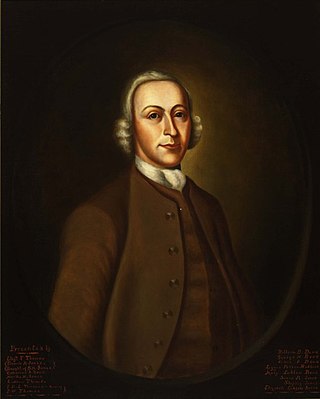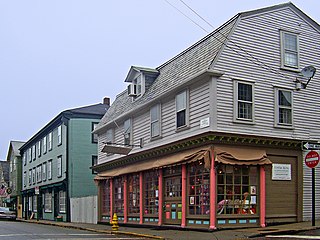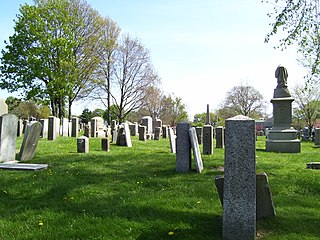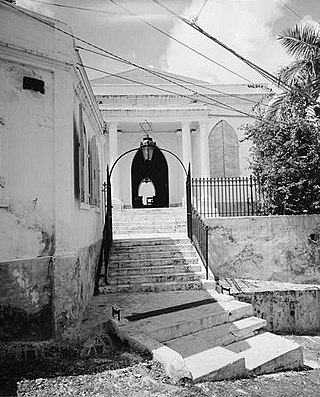History
The cemetery was founded in 1677 or possibly earlier. In the Newport land records, a deed was recorded on 28 Feb 1677 for a certain parcel of land, 30 feet square, sold by Nathaniel Dickens to Mordecai Campannall and Moses Packechoe for a burial-place for the Jews of Newport, and this purchase may have been an addition to a cemetery that was already in existence as of that date. [2]
The synagogue is the oldest surviving synagogue building in the United States, and the cemetery is the second oldest Jewish cemetery in the country. The cemetery gates are decorated with torches turned to face downward, an acknowledgement of the ending of life's flame. Prior to the establishment of Temple Ohabei Shalom Cemetery in Boston in 1844, Jews from Massachusetts were sent to the Touro Synagogue Cemetery, the West Indies, or Europe for burial in sacred ground.
Judah Touro, a philanthropist who was born and reared in Newport, contributed $40,000, an immense sum at the time, to the Jewish cemetery at Newport. This funded the restoration and maintenance of the cemetery. He is buried in the Jewish cemetery of Newport. The inscription on his tombstone reads: "To the Memory of / Judah Touro / He inscribed it in the Book of / Philanthropy / To be remembered forever." [3] [4]
The cemetery's Egyptian revival gate and fence were designed by Boston architect Isaiah Rogers (1810–49) who designed an identical gate for Boston's Old Granary Burying Ground. [5]
By the mid-19th century, the maritime prosperity that built Newport's fine colonial churches, synagogue, public buildings and homes had vanished when the port of Providence superseded Newport after the British destroyed Newport's wharves during the American Revolution. The great mansions of Newport in the Gilded Age were still in the future. Newport in the 1850s was an old seaport town whose air of genteel decay and cool sea breezes had recently begun to attract members of Boston's intellectual elite as a summer retreat. There were virtually no Jews in Newport in this period; the synagogue was shuttered.
American writer Henry Wadsworth Longfellow visited the area in July 1852 and showed an interest more in the cemetery than in the synagogue, which he described as being "a shady nook, at the corner of two dusty, frequented streets". [6] Longfellow was inspired to write his poem "The Jewish Cemetery at Newport" during this visit. Longfellow, a scholar who knew Hebrew, begins his poem by expressing his surprise at coming upon a synagogue in an old New England port town, due to the dearth of Jews in New England during that time and the Colonial era.
The American Jewish poet Emma Lazarus wrote a sort of redux of Longfellow's poem in 1867 [7] titled, "In the Jewish Synagogue at Newport". Some interpreters contend that Lazarus intended with her poem to let Longfellow know that the Jews might be down, but that they were not dead. [8] However, this interpretation matches neither the mournful tone nor the explicit references to the defunct nature of the Newport synagogue, such as "no signs of life", and the general reference to Hebrew as "a language dead", not to mention the concluding line referring to "the mystery of death". In this latter interpretation, Lazarus was concurring with Longfellow regarding the sanctity of Jewish memory while acknowledging the unlikelihood of a Jewish national revival, which really only blossomed in the decade following the deaths of Longfellow and Lazarus.

Newport is a seaside city on Aquidneck Island in Rhode Island, United States. It is located in Narragansett Bay, approximately 33 miles (53 km) southeast of Providence, 20 miles (32 km) south of Fall River, Massachusetts, 74 miles (119 km) south of Boston, and 180 miles (290 km) northeast of New York City. It is known as a New England summer resort and is famous for its historic mansions and its rich sailing history. The city has a population of about 25,000 residents.

The Touro Synagogue or Congregation Jeshuat Israel is a synagogue built in 1763 in Newport, Rhode Island. It is the oldest synagogue building still standing in the United States, the only surviving synagogue building in the U.S. dating to the colonial era, and the oldest surviving Jewish synagogue building in North America. In 1946, it was declared a National Historic Site.

The Granary Burying Ground in Massachusetts is the city of Boston's third-oldest cemetery, founded in 1660 and located on Tremont Street. It is the burial location of Revolutionary War-era patriots, including Paul Revere, the five victims of the Boston Massacre, and three signers of the Declaration of Independence: Samuel Adams, John Hancock, and Robert Treat Paine. The cemetery has 2,345 grave-markers, but historians estimate that as many as 5,000 people are buried in it. The cemetery is adjacent to Park Street Church, behind the Boston Athenaeum and immediately across from Suffolk University Law School. It is a site on Boston's Freedom Trail. The cemetery's Egyptian revival gate and fence were designed by architect Isaiah Rogers (1800–1869), who designed an identical gate for Newport's Touro Cemetery.

Isaiah Rogers was an American architect from Massachusetts who eventually moved his practice south, where he was based in Louisville, Kentucky, and Cincinnati, Ohio. He completed numerous designs for hotels, courthouses and other major buildings in Boston, Massachusetts, and New York City, before that relocation.

Judah Touro was an American businessman and philanthropist.

Touro Synagogue is a Reform Jewish synagogue located at 4238 St. Charles Avenue, in Uptown New Orleans Louisiana. It was named after Judah Touro, the son of Isaac Touro, the namesake of the country's oldest synagogue, Touro Synagogue in Newport, Rhode Island. The New Orleans Touro Synagogue is one of the oldest synagogues in the United States and the oldest in the country outside the original Thirteen Colonies.

Isaac Touro was a Dutch-born American rabbi. He was a Jewish leader in colonial America. Born in Amsterdam, in 1758 he left for Jamaica. In 1760, he arrived in Newport, Rhode Island, to serve as hazzan and spiritual leader of Jeshuath Israel, a Portuguese Sephardic congregation. Soon after his arrival, the congregation built the Touro Synagogue, which is the oldest synagogue in the United States.

Peter Harrison was a colonial American architect in New England who is credited with bringing the Palladian architectural movement to the colonies.
Rabbi Morris Aaron Gutstein was an American Rabbi. He was a prominent congregational Rabbi in Newport, Rhode Island, and Chicago, Illinois, and a historian best known for his work on the history of the Jewish community of colonial Newport.

Temple Ohabei Shalom Cemetery is a historic Jewish cemetery located at 147 Wordsworth Street in East Boston, Massachusetts.
Shangarai Chasset, also called Shaarei Chesed, was an Orthodox and later, Reform, Jewish congregation and synagogue, located in New Orleans, Louisiana, in the United States. The congregation worshipped in the Sefardi rite.

The Newport Historic District is a historic district that covers 250 acres in the center of Newport in the U.S. state of Rhode Island. It was designated a National Historic Landmark (NHL) in 1968 due to its extensive and well-preserved assortment of intact colonial buildings dating from the early and mid-18th century. Six of those buildings are themselves NHLs in their own right, including the city's oldest house and the former meeting place of the colonial and state legislatures. Newer and modern buildings coexist with the historic structures.

The Common Burying Ground and Island Cemetery are a pair of separate cemeteries on Farewell and Warner Street in Newport, Rhode Island. Together they contain over 5,000 graves, including a colonial-era slave cemetery and Jewish graves. The pair of cemeteries was added to the National Register of Historic Places as a single listing in 1974.

Aaron Lopez (1731–1782), born Duarte Lopez, was a merchant, slave trader, and philanthropist in colonial Rhode Island. Through his varied commercial ventures, he became the wealthiest person in Newport, Rhode Island. In 1761 and 1762, Lopez unsuccessfully sued the Rhode Island colonial government for citizenship.

St. Thomas Synagogue, officially Congregation Beracha Veshalom Vegmiluth Hasadim or The Hebrew Congregation of St. Thomas, is a historic Reform Jewish synagogue located at 2116 Crystal Gade, Queens Quarters, in Charlotte Amalie on the island of Saint Thomas in the U.S. Virgin Islands. The synagogue building was declared a National Historic Landmark in 1997.

Moses Michael Hays was an American banker, merchant, and philanthropist. As Boston's most prominent 18th-century Jewish citizen, Moses Michael Hays set a high standard for civic leadership and charity.



















